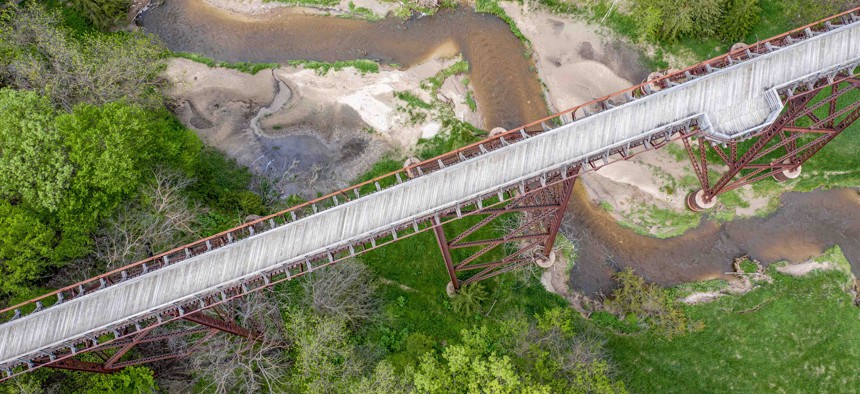Mile-by-Mile, Proposed Nationwide Bike and Foot Trail Sees Progress

A bridge over a creek along Nebraska's Cowboy Trail. Shutterstock

Connecting state and local government leaders
Advocates for the trail say there are now over 2,000 miles of segments complete and that more money flowed toward the project this past year.
The group pushing to build a bike and pedestrian pathway that would stretch over 3,700 miles from the eastern seaboard to the Pacific Northwest coast said this week that organizations involved in the project secured more than $4 million in government and private funding for it this past year and completed another 20-plus miles of trail along the corridor.
With that progress, there are now upwards of 2,000 miles of trail segments built on the route. As planned, the trail would cross 12 states, running between Washington, D.C. and Washington state. Supporters say the project would not only provide a route for long distance cyclists, but would also help improve and connect local trail networks that could be used regularly by millions of people living near them.
They also point to the potential for business opportunities and economic development in communities along the proposed corridor. The Rails-to-Trails Conservancy, the main group behind the project, estimates that there is $34 billion in annual economic activity tied to trails in the U.S. and says the sum could grow to $138 billion in future years as trail infrastructure improves.
Ryan Chao, the conservancy’s president, said in a statement that the coronavirus outbreak has highlighted the value of amenities like trails as people look for more activities to do outside, seeking to avoid the risk of catching the virus indoors. “Closing critical gaps in the trail has the potential to deliver significant economic value,” Chao added, “which will be so important as we move beyond the pandemic.”
Groups at the local level are playing key roles in advancing the nationwide trail.
In Iowa, local organizations have been working for the past couple years to build a 9-mile stretch near Des Moines that would fill in a gap between two popular trails that see hundreds of thousands of visits each year—the Raccoon River Valley Trail and the High Trestle Trail.
Mike Wallace, executive director of the conservation board in Dallas County, Iowa said that there are plans and funding lined up for next year to pave another mile of that missing section and to build a major bridge over a creek.
The link between the two trails “is one of the most demanded segments in the state,” according to Andrea Boulton, statewide trails and greenways director for the Iowa Natural Heritage Foundation. She noted that the connection would allow for about 100 miles of continuous travel by trail in central Iowa, while also contributing to the completion of the national project.
Brittany Helmbrecht, president of the Northwest Nebraska Trail Association described during an online event the Rails-to-Trails Conservancy held this week some of the latest progress on the state’s Cowboy Trail, extending about 321 miles west from Norfolk, Nebraska. About 192 miles of the trail features an improved limestone surface. The state’s Game and Parks Commission bills the trail as the largest rails-to-trails conversion project in the country.
Helmbrecht explained how the Nebraska Northwestern Railroad recently granted an easement along an active railway so the trail could be extended about 5 miles into Chadron, a city in northwest Nebraska.
“We’re really excited for what this trail means for our community,” she said.
The Rails-to-Trails Conservancy has acknowledged that the full cross-country trail will likely take years to complete. It unveiled its proposed route for the project in mid-2019. Seeing the project through will involve not only constructing new sections of trail, but also carrying out upgrades on existing segments along the corridor.
In the east, travelers along the proposed trail route would move along the Chesapeake and Ohio Canal National Historical Park towpath in the Washington, D.C. and Maryland region.
Robin Zanotti, president of the C&O Canal Trust, said this week that about 40 miles of an 80-mile, five-year resurfacing plan for that trail was now complete. She noted that funds have flowed from the state and the National Park Service to help pay for upgrades.
“It’s not really all that safe, in certain places, for most of us,” Zanotti said of the towpath's condition. “One of the things that was important to us in doing this resurfacing was accessibility.”
President-elect Joe Biden, as part of his climate and infrastructure agenda, has proposed creating a “Civilian Climate Corps” to work on a range of conservation-oriented projects, including trails. It’s far from clear when and if a proposal like that has any chance of getting enacted, or how the initiative might help to support the transcontinental trail project.
Bill Lucia is a senior reporter for Route Fifty and is based in Olympia, Washington.

NEXT STORY: Cloud-based video tools keep county operating





